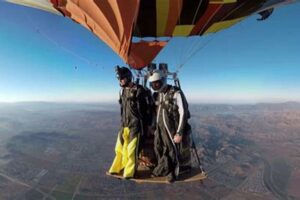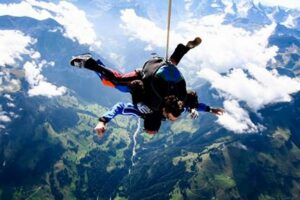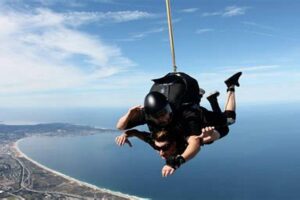Table of Contents
Skydiving Height: A Thrilling Leap from the Clouds
In the realm of adventure sports, skydiving stands as a pinnacle of exhilaration, where individuals willingly plummet from dizzying altitudes to experience the rush of freefall. The height from which one skydives, known as “skydiving height,” plays a critical role in determining the intensity and duration of the skydiving experience.
The standard skydiving height ranges from 10,000 to 13,000 feet above ground level. This altitude provides ample time for skydivers to enjoy the breathtaking views, stabilize their freefall, and deploy their parachutes safely. Skydiving from greater heights, such as 15,000 or even 20,000 feet, is often reserved for experienced skydivers seeking an extended freefall experience.
The significance of skydiving height goes beyond the mere thrill it offers. It directly influences the safety and enjoyment of the skydive. Higher altitudes allow for a longer freefall, providing more time to maneuver, stabilize, and deploy the parachute. Additionally, the increased altitude offers a more comprehensive and awe-inspiring view of the surrounding landscape, enhancing the overall skydiving experience.
Skydiving Height
In the exhilarating realm of skydiving, the height from which one leaps significantly influences the experience. Understanding the essential aspects of skydiving height is paramount for both safety and enjoyment.
- Altitude: The height above ground level from which the skydive is performed.
- Freefall Time: The duration of the skydive before the parachute is deployed.
- Safety: Higher altitudes allow for more time to stabilize and deploy the parachute.
- Thrill: Higher altitudes provide a longer freefall, intensifying the adrenaline rush.
- Experience: Skydivers with more experience may opt for higher altitudes for a more challenging jump.
- Views: Higher altitudes offer breathtaking panoramic views of the surrounding landscape.
- Regulations: Some countries or skydiving organizations have specific regulations regarding skydiving height.
These aspects are interconnected and influence each other. For instance, higher altitudes typically result in longer freefall times, providing more time to enjoy the rush of the fall. However, higher altitudes also demand greater skill and experience to ensure a safe and controlled descent. Understanding these aspects helps skydivers make informed decisions about the altitude from which they wish to jump, ensuring a thrilling yet safe skydiving experience.
Altitude
Altitude, the height from which a skydive is performed, stands as a pivotal factor influencing the entire skydiving experience. It not only dictates the duration of the freefall but also impacts safety, thrill, and the overall enjoyment of the jump.
- Jump Platform: The platform from which the skydiver exits the aircraft. Common platforms include airplanes, helicopters, and hot air balloons.
For example, skydivers often jump from airplanes at altitudes ranging from 10,000 to 13,000 feet, while BASE jumpers may leap from cliffs, buildings, or bridges at much lower altitudes.
Freefall Duration: The length of time a skydiver spends in freefall before deploying the parachute. This duration is directly influenced by the altitude from which the jump is made.
Higher altitudes result in longer freefall times, providing more time to stabilize, enjoy the rush, and perform maneuvers. Experienced skydivers may seek higher altitudes for extended freefall experiences.
Safety Considerations: Altitude plays a crucial role in skydiving safety. Higher altitudes allow for more time to stabilize the freefall and deploy the parachute safely.
Additionally, higher altitudes provide a larger margin for error in case of equipment malfunctions or other unexpected events.
Thrill Factor: The adrenaline rush and overall thrill of a skydive are directly proportional to the altitude. Higher jumps offer a more intense and exhilarating experience due to the increased speed and longer freefall time.
Skydivers seeking an elevated thrill factor may opt for higher altitudes, while those prioritizing safety and a more controlled experience may choose lower altitudes.
In conclusion, altitude, as the height from which a skydive is performed, serves as a multifaceted aspect that profoundly affects the safety, thrill, and overall enjoyment of the skydiving experience. Skydivers carefully consider the altitude based on their experience, skill level, and desired level of intensity, ensuring a jump that aligns with their goals and abilities.
Freefall Time
In the realm of skydiving, freefall time holds a central place, intricately intertwined with the concept of skydiving height. It signifies the exhilarating phase of the skydive, where the jumper plummets towards the earth at high speeds, experiencing the rush of the wind and the thrill of unencumbered descent. Understanding the various facets and implications of freefall time is key to appreciating the nuances of this exhilarating activity.
- Duration:
Freefall time is the duration between the moment the skydiver exits the aircraft and the moment the parachute is deployed. It can range from a few seconds to over a minute, depending on the altitude and the skydiver’s preferences.
- Factors Influencing Freefall Time:
The primary factor influencing freefall time is altitude. Higher altitudes provide longer freefall times, while lower altitudes result in shorter durations. Additionally, factors like the jumper’s body position and the type of parachute used can also affect freefall time.
- Skill and Experience:
Skilled and experienced skydivers often seek longer freefall times to maximize their enjoyment and perform complex maneuvers. Conversely, beginners typically opt for shorter freefall times to prioritize safety and control.
- Safety Considerations:
Longer freefall times demand greater skill and awareness from the skydiver. Sufficient altitude is crucial to allow ample time for parachute deployment and stabilization before reaching the ground. Safety regulations often dictate minimum freefall times based on the altitude.
In conclusion, freefall time serves as a defining element of the skydiving experience, influenced by various factors such as altitude, skill level, and safety considerations. Skydivers carefully evaluate these aspects to tailor their jump to their desired level of thrill and ensure a safe and exhilarating descent.
Safety
In the realm of skydiving, safety is paramount, and skydiving height plays a crucial role in ensuring a safe and controlled descent. Higher altitudes provide skydivers with more time to stabilize their freefall, perform necessary checks, and deploy their parachute safely. This increased time buffer enhances the overall safety of the skydiving experience.
The connection between skydiving height and safety is evident in several ways. Firstly, higher altitudes allow skydivers to reach a stable freefall position before deploying their parachute. This stability is essential for ensuring proper parachute deployment and inflation, reducing the risk of malfun
ctions or entanglement. Additionally, higher altitudes provide more time for skydivers to assess their surroundings, check their equipment, and make any necessary adjustments before deploying the parachute.
Real-life examples further illustrate the importance of higher altitudes for safety in skydiving. In cases where skydivers have experienced equipment malfunctions or sudden changes in weather conditions, the additional time afforded by higher altitudes has enabled them to react appropriately and deploy their parachute safely. These incidents highlight the critical role of skydiving height in mitigating risks and enhancing the overall safety of the sport.
The understanding of the relationship between skydiving height and safety has practical applications in various aspects of the sport. Skydiving instructors emphasize the importance of choosing an appropriate jump altitude based on experience and skill level. They train skydivers to perform thorough equipment checks and maintain stable freefall positions to ensure safe parachute deployment. Moreover, skydiving regulations often mandate minimum jump altitudes to ensure sufficient time for parachute deployment and stabilization.
In conclusion, the connection between skydiving height and safety is undeniable. Higher altitudes provide skydivers with more time to stabilize their freefall, perform necessary checks, and deploy their parachute safely, reducing the risk of accidents and enhancing the overall safety of the sport. This understanding guides skydivers, instructors, and regulators in making informed decisions to ensure a safe and enjoyable skydiving experience.
Thrill
In the exhilarating realm of skydiving, altitude plays a pivotal role in orchestrating the symphony of emotions experienced during the jump. Higher altitudes unlock a gateway to amplified thrills, as they orchestrate a longer freefall, amplifying the adrenaline rush to intoxicating levels.
- Height and Adrenaline:
As the skydiver ascends to greater heights, the anticipation and excitement build, culminating in an adrenaline surge as they take the leap. The longer freefall granted by higher altitudes prolongs this adrenaline rush, creating an exhilarating crescendo.
- Speed and Sensory Overload:
With increased altitude comes a heightened sense of speed as the skydiver plummets towards the earth. This surge of velocity intensifies the sensory experience, inducing a rush of exhilaration as the wind whips past and the landscape transforms into a blur.
- Conquering Fear:
For many skydivers, the allure of higher altitudes lies in the challenge of overcoming their fears. Confronting the inherent risks and pushing their limits generates an intense rush of adrenaline, leaving them with a profound sense of accomplishment.
- Breathtaking Views:
Higher altitudes unveil breathtaking vistas that add a visual dimension to the thrilling experience. Skydivers can marvel at the panoramic landscapes, intricate patterns of clouds below, and the curvature of the earth, creating lasting memories.
The interplay between skydiving height and thrill is a captivating dance of exhilaration and risk. Skydivers seek higher altitudes to intensify their experience, to push their boundaries, and to create lifetime memories. As they ascend, their hearts pound, their senses heighten, and they willingly surrender to the intoxicating embrace of adrenaline, forever etching the experience into their souls.
Experience
In the realm of skydiving, experience and altitude are inextricably linked. As skydivers accumulate jumps and refine their skills, they often seek higher altitudes to elevate the challenge and intensity of their skydiving experience.
The relationship between experience and skydiving height is multifaceted. Firstly, experienced skydivers possess the necessary skills and knowledge to handle the increased complexity and risks associated with higher altitudes. They have mastered the techniques required to maintain stability, control their descent, and deploy their parachute safely, even in challenging conditions.
Secondly, higher altitudes provide experienced skydivers with an opportunity to expand their skillset and push their limits. By jumping from greater heights, they can practice advanced maneuvers, improve their freefall control, and gain a deeper understanding of the sport’s intricacies.
Real-life examples abound of experienced skydivers seeking out higher altitudes for a more challenging jump. World-renowned skydiver Felix Baumgartner made history in 2012 when he jumped from a record-breaking altitude of 128,100 feet, pushing the boundaries of human possibility.
The understanding of the connection between experience and skydiving height has practical applications in various aspects of the sport. Skydiving instructors carefully assess a student’s experience and skills before determining the appropriate jump altitude, ensuring a safe and enjoyable experience. Additionally, skydiving regulations often mandate minimum experience requirements for jumping from higher altitudes.
In conclusion, the connection between experience and skydiving height is a testament to the dynamic nature of the sport. As skydivers progress in their journey, they seek higher altitudes to challenge themselves, hone their skills, and experience the exhilaration of freefall from new perspectives. This understanding guides instructors, regulators, and skydivers alike in making informed decisions to ensure safe and progressively challenging skydiving experiences.
Views
In the exhilarating realm of skydiving, the height from which one jumps significantly influences the experience. One captivating aspect of skydiving height is the breathtaking panoramic views it offers. As skydivers ascend to greater altitudes, they are greeted with a visual spectacle that transcends the ordinary, leaving them in awe of the surrounding landscape.
- Unparalleled Perspective:
Skydiving from higher altitudes grants jumpers an unparalleled perspective, allowing them to witness the world from a vantage point like no other. They can marvel at the intricate patterns of fields, the meandering rivers, and the vast expanse of the horizon stretching out before them.
- Cloud Formations:
Higher altitudes often bring skydivers up close and personal with cloud formations. They can witness the stunning beauty of cloud patterns from above, observing their ever-changing shapes and textures. This encounter with the clouds adds an ethereal and otherworldly element to the skydiving experience.
- Geographical Features:
Jumping from higher altitudes offers skydivers a chance to appreciate the geographical features of the region they are jumping in. Whether it’s the majestic peaks of mountain ranges, the sprawling coastline, or the intricate network of rivers and lakes, these features take on a new significance when viewed from above.
- Awe-Inspiring Sunrises and Sunsets:
For those fortunate enough to experience a sunrise or sunset during their skydive, the views are simply breathtaking. The interplay of colors as the sun rises or sets, combined with the vastness of the horizon, creates a moment of awe and wonder that is unmatched.
The panoramic views offered by higher altitudes in skydiving are not just a visual treat; they also contribute to the overall exhilaration of the experience. The vastness of the landscape below serves as a stark contrast to the confined space of the aircraft, intensifying the feeling of freedom and liberation that skydiving offers. These awe-inspiring views leave skydivers with lasting memories of their jump and a renewed appreciation for the beauty of the world.
Regulations
The relationship between regulations governing skydiving height and the overall skydiving experience is mu
ltifaceted, encompassing safety, consistency, and responsible participation in the sport.
Regulations on skydiving height are primarily driven by safety considerations. By establishing minimum and maximum jump altitudes, authorities aim to ensure that skydivers have sufficient time for parachute deployment and to minimize the risk of accidents. For instance, the United States Parachute Association (USPA) mandates a minimum jump altitude of 2,500 feet above ground level (AGL) for sport skydiving and a maximum altitude of 18,000 feet AGL.
Furthermore, regulations help maintain consistency and standardization in skydiving practices. By setting clear guidelines for jump altitudes, skydiving organizations can ensure that all participants adhere to a common set of rules and procedures, promoting a safe and orderly environment. This is particularly important in large-scale skydiving events or competitions, where multiple skydivers may be jumping simultaneously.
Regulations also play a role in promoting responsible participation in skydiving. By requiring skydivers to meet certain experience and training requirements before attempting jumps from higher altitudes, authorities aim to mitigate risks and ensure that only qualified individuals engage in potentially dangerous activities.
Real-life examples abound of the practical applications of skydiving height regulations. In countries like Switzerland and Nepal, strict height restrictions are imposed on skydiving activities due to concerns over airspace management and potential hazards to aircraft. Additionally, many skydiving schools and drop zones have their own internal regulations regarding jump altitudes, often influenced by factors such as the skill level of the participants and the type of skydiving being performed.
In conclusion, the regulations governing skydiving height serve as a vital component of the sport, ensuring safety, consistency, and responsible participation. These regulations are not merely arbitrary restrictions but are carefully designed to mitigate risks, maintain standards, and promote the long-term sustainability of skydiving as a thrilling and accessible activity.
Frequently Asked Questions
This section addresses common queries and aims to clarify various aspects of skydiving height, providing insightful answers to frequently encountered questions.
Question 1: What is the standard skydiving height?
Answer: Skydiving heights typically range from 10,000 to 13,000 feet above ground level (AGL), offering a balance between safety and an exhilarating freefall experience.
Question 2: How does skydiving height affect the freefall duration?
Answer: Higher altitudes result in longer freefall times, allowing for more time to enjoy the rush of the fall and perform maneuvers. Experienced skydivers may opt for higher altitudes to extend their freefall experience.
Question 3: Is higher always better in terms of skydiving height?
Answer: Not necessarily. Skydiving height should be chosen based on experience and skill level. Higher altitudes require more experience and proficiency to manage the increased risks and complexities associated with them.
Question 4: What safety considerations are tied to skydiving height?
Answer: Higher altitudes provide a larger margin for error in case of equipment malfunctions or unexpected events. They also allow more time for parachute deployment and stabilization, enhancing the overall safety of the skydive.
Question 5: How does skydiving height influence the thrill factor?
Answer: Higher altitudes intensify the adrenaline rush and overall thrill of a skydive due to the increased speed and longer freefall time. Skydivers seeking an elevated thrill factor may opt for higher jumps.
Question 6: Are there regulations governing skydiving height?
Answer: Yes, some countries and skydiving organizations have specific regulations regarding skydiving height. These regulations are primarily driven by safety concerns and aim to ensure that skydivers have sufficient time for parachute deployment and to minimize the risk of accidents.
These FAQs provide valuable insights into the concept of skydiving height, addressing common concerns and clarifying its various aspects. As we delve further into the topic, we will explore the factors that influence the choice of skydiving height and the training and experience required for safe and enjoyable jumps at different altitudes.
Tips for Choosing the Right Skydiving Height
Selecting the appropriate skydiving height is crucial for a safe and enjoyable experience. Here are some essential tips to consider:
Tip 1: Assess Your Experience:
Evaluate your skill level and experience before determining the jump altitude. Higher altitudes require more experience to manage the increased risks and complexities.
Tip 2: Consider the Type of Skydive:
Different types of skydiving, such as solo jumps, tandem jumps, or formation skydiving, may have specific altitude requirements. Choose accordingly.
Tip 3: Listen to Your Instructor:
Skydiving instructors are trained professionals who can assess your skills and recommend an appropriate jump altitude based on your experience and abilities.
Tip 4: Understand Safety Regulations:
Familiarize yourself with local skydiving regulations and altitude restrictions. These regulations are in place to ensure the safety of all skydivers.
Tip 5: Choose a Suitable Drop Zone:
Select a drop zone that caters to your experience level and jump altitude preferences. Some drop zones have specific height restrictions or specialize in certain types of skydiving.
Tip 6: Start Gradually and Progress Safely:
Begin with lower altitudes and gradually increase the height as you gain experience and confidence. This approach allows you to develop the necessary skills and adapt to the demands of higher jumps.
Tip 7: Consider the Weather Conditions:
Weather conditions can significantly impact the skydiving experience. Strong winds or low visibility may necessitate lower jump altitudes for safety reasons.
Tip 8: Prioritize Safety Above All:
Always prioritize safety when choosing the skydiving height. Never attempt jumps from altitudes beyond your skill level or comfort zone.
Remember, the goal is to enjoy a thrilling and memorable skydiving experience while maintaining safety as the top priority. By following these tips, you can make informed decisions about the appropriate jump altitude for your skill level and circumstances.
As we conclude our discussion on choosing the right skydiving height, it’s essential to emphasize that safety should always come first. By considering these tips and seeking guidance from experienced instructors, skydivers can minimize risks and maximize their enjoyment during this exhilarating activity.
Conclusion
Our exploration of skydiving height has revealed the intricate interplay between altitude, safety, thrill, experience, views, and regulations. Key insights emerged, highlighting the importance of selecting an appropriate jump altitude based on skill level, considering safety regulations, and prioritizing safety above all else.
- Altitude and Safety: Higher altitudes provide more time for parachute deployment and stabilization, enhancing safety. However, they demand greater skill and experience to manage increased risks.
- Altitude and Thrill: Higher jumps intensify the adrenaline rush and overall thrill due to increased speed and longer freefall time. Skydivers seeking an elevated thrill factor may opt for higher altitudes.
- Skill, Experience, and Altitude: As skydivers gain experience and proficiency, they may seek higher altitudes to challenge themselves, expand their skillset, and experience the exhilaration of freefall from new perspectives.
In the realm of skydiving, the choice of altitude is not merely a matter of preference; it’s a critical decision that intertwines safety, skill, and the pursuit of exhilarating experiences. Skydivers must carefully consider these factors, guided by experienced instructors and adhering to safety regulations, to ensure a thrilling and unforgettable skydiving adventure.







